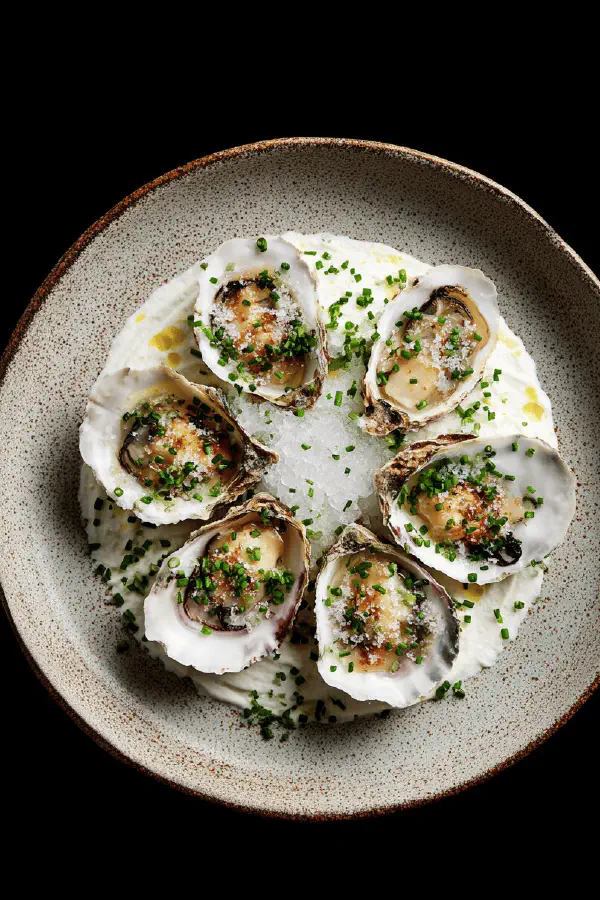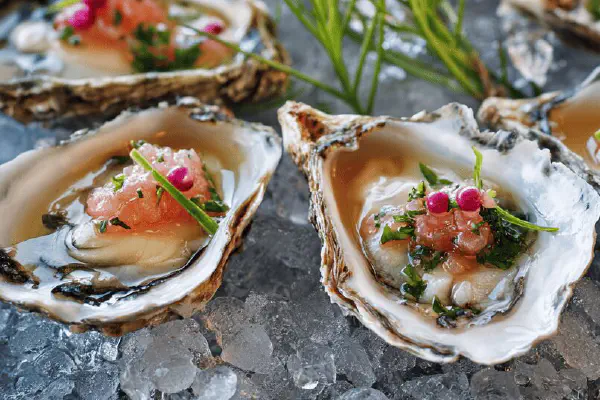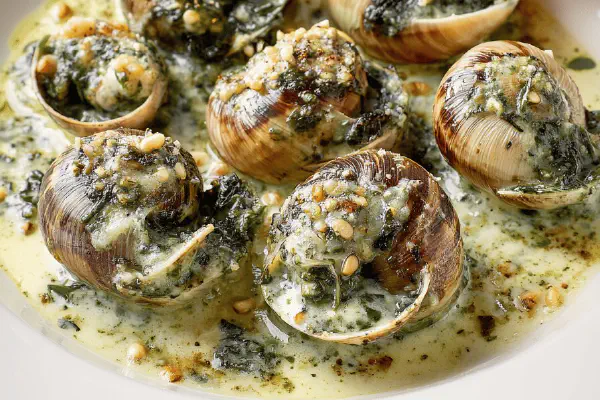Featured Recipe
Fresh Oysters with Shallot Foam

By Kate
"
Shellfish dish of fresh oysters served with an aerated shallot-lime espuma. Uses chopped shallots softened in butter with lemon juice instead of white wine vinegar. Cream and egg yolk make a rich foam via nitrous oxide siphon. Garnished with chives and a light dusting of smoked sea salt. Ready in under 45 minutes total with active prep and chilling. Gluten and nut free. Two dozen oysters yield about 8 servings. A seafood appetizer with a light, tangy contrast to briny oysters. Adaptable with white fish or clams
"
Prep:
35 min
Cook:
10 min
Total:
45 min
Serves:
8 servings
seafood
oysters
appetizer
French cuisine
Introduction
Raw oysters crave bold but balanced partners. That tangy bite, the ocean salinity. Picture a foam, light as air, with soft caramelized shallots brightened by citrus. No heavy sauces here — a delicate contrast instead. Butter mellows shallots then lime juice snatches acidity. Egg yolk blends richness and body; cream lends weight to the foam. Worked in a siphon with nitrous oxide, a modernist touch that captures air precisely for texture. Takes some time but worth patience. Oysters chill on crushed ice ready to meet the sauce. A touch of fresh chives pops green color and sharp onion notes. A sprinkle of smoked salt wakes the senses. Forget long waits — most of the work happens while chilling. The payoff is instant elegance on shell. If lacking oysters, replace with clams or small white fish slices for same flavor interplay. Keep tools cold, don’t rush cooking shallots, a crucial stage to avoid bitterness. Every step hones in on freshness and contrast.
Ingredients
About the ingredients
Use fresh French shallots preferably for their mild sweetness but red or yellow onions work as substitutes—adjust cooking times to soften longer. Butter is best for the nutty base; avoid oils with high smoke points to preserve shallot flavor. Lime juice replaces white wine vinegar for a zesty fresh twist but lemon or even a white balsamic could fit. Heavy cream should be well chilled for siphon stability; 35% fat content keeps foam from weeping quickly. Egg yolk binds fat and acid, but if concerned about raw egg use pasteurized or omit—foam texture changes but still works. Oysters must be fresh and kept cold; shucking requires steady hand and thick gloves to prevent injury. Chives deliver freshness but scallion greens sliced thin also work. Smoked sea salt is optional but adds umami and depth—regular flaky salt okay if unavailable. Keep all ingredients cold except the initial saute stage. Siphon cartridge must be fully punctured but not over-tightened. Equipment cleaning after use avoids spoilage smells. Refrigerate siphon upright to maintain foam volume.
Method
Technique Tips
Don’t just time cook—watch shallots carefully. They should soften until translucent and edges lightly caramelized but not brown or bitter. Listen for gentle sizzling, a sign of medium heat over burn risk. When acid hits pan, it should hiss softly, bubbling until reduced by half. Transfer to blender immediately to avoid further cooking and bitterness. Blend until smooth but avoid overblending to prevent foam collapse later. Passing through sieve catches fibers for velvety foam. When loading siphon, ensure mixture is cold or foam deflates quickly. Screw cartridge firmly to prevent leaks, shake head down multiple times to saturate gas. Chill siphon minimum 90 minutes, shaking intermittently to maintain aeration. Oyster shucking needs firm pressure; drop half opened shells on non-slip surface to separate hinge gently. Use crushed ice bed to keep oysters cold and stable for serving. Foam is delicate—apply sparingly or it slides off oyster. Fresh chives on top add color and slight oniony crunch. Serve immediately to enjoy contrast of warm shell and cold foam. If foam droops, quick gentle shake can revive volume but avoid repeated heavy shaking. Never pre-foam too early—serving quality drops with time.
Chef's Notes
- 💡 Start with chilled tools. Siphon keeps foam airy. Cold shallots prevent bitterness. Butter enhances sweetness. Watch your shallots. Soft, not browned, about 7-9 minutes. Keep stirring gently.
- 💡 If no French shallots available, red or yellow onions work too. Just adjust cooking time. Keep texture consistent. Lime juice brightens flavor profile. If no lime, lemon or white balsamic fits.
- 💡 Oyster shucking can be tricky. Firm grip, careful pressure. Open shell slightly, slide knife. Protect hands with thick gloves. Shuck slowly to avoid injury. Preserve natural liquor inside.
- 💡 Serving oysters on crushed ice keeps them fresh. Helps maintain temperature. Presentation matters. Aesthetics enhance enjoyment. Lightly dust with smoked sea salt for added depth.
- 💡 If foam collapses, don’t panic. Quick shake can revive it. Add air back gently. Over-shaking can ruin texture. Apply foam sparingly. Too much slides off, makes a mess.
Kitchen Wisdom
What if my shallots turn bitter?
If they brown, it's overcooked. Lower heat next time. Keep stirring until soft. Check smell. Should be sweet.
How do I store leftovers?
Oysters are best fresh. Can refrigerate for one day but texture suffers. Foam won't hold. Think about half servings.
What can I use instead of oysters?
Clams or small white fish slices work well. Adjust cooking methods slightly. Still get that sea flavor.
My siphon isn’t working right.
Ensure cartridge is punctured properly. Shake head down, don't over-tighten. Cold mixture is key.



